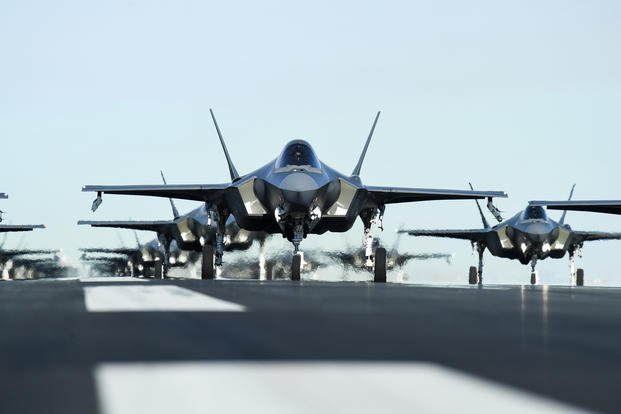Lockheed Martin Corp. recently paused F-35 Joint Strike Fighter deliveries over an internal gas issue that could cause the stealth fighter to explode if struck by lightning.
The company said Wednesday that maintainers performing a routine maintenance check at the Ogden Air Logistics Complex in Utah found damage to a tube within the Onboard Inert Gas Generation System, known as OBIGGS, in the Air Force's variant of the Lightning II jet.
Read Next: Navy Ship Names Could Fall Under Pentagon’s New Diversity Review
"Lockheed Martin initiated a delay in deliveries while we verified F-35 production is conforming to specifications with regard to OBIGGS installation," the company said in a statement. "We are working with the F-35 Joint Program Office on a root cause corrective action investigation to determine next steps, as it appears this anomaly is occurring in the field after aircraft delivery."
While deliveries have resumed after a nearly four-week pause, the JPO has advised local F-35A squadron commanders to avoid flying "within 25 miles of lightning or thunderstorms," according to the statement. Lightning strikes on aircraft are statistically rare, occurring about once per year according to the Federal Aviation Administration.
The advisory guidance will remain in place until the root cause and corrective action investigation is complete, said JPO spokeswoman Brandi Schiff. "The safety of F-35 operators remains an enduring high priority for the JPO," Schiff said in an email.
Earlier this month, Bloomberg reported the flawed tubing was found within 14 of 24 Air Force models of the fighter jet undergoing inspection. Lockheed Martin spokesman Brett Ashworth told Defense News the flaw seems to be limited to the Air Force's variant of the jet, which is also the version flown by the majority of the program's international partners.
The OBIGGS works to replace much of the oxygen built up in the fuel tank with nitrogen. Doing so helps prevent vapors in the fuel tank from combusting should the jet be struck by lightning.
The F-35 has seen this problem before: The Pentagon's Director of Operational Test and Evaluation (DOT&E) disclosed the deficiency, dating back to 2009, in a 2012 report, saying, "The system is not able to maintain fuel tank inerting through some critical portions of a simulated mission profile."
The Defense Department at the time called for a similar moratorium on flights during storms to avoid lightning strikes. The deficiency prompted a redesign to "more uniformly distribute the nitrogen-enriched air throughout the fuel tanks," according to a DOT&E report.
The flight restrictions were lifted in 2014 following a fix, according to Defense News.
The F-35 program's total cost has been projected at more than $1 trillion over a 50-year service lifetime. Its past has been plagued with breakdowns -- including engine fires, structural cracks, and peeling and crumbling insulation in its cooling lines -- along with cost overruns.
Production was also halted for two weeks in November after developers discovered a "co-mingling" of different types of fasteners being used on the aircraft.
Despite continuing issues, the Pentagon in October finalized a $34 billion agreement with Lockheed for the next three batches of F-35s -- firming up a deal for 478 F-35 aircraft, the largest purchase to date.
-- Oriana Pawlyk can be reached at oriana.pawlyk@military.com. Follow her on Twitter at @Oriana0214.
Related: Trump Hints at Removing Foreign Manufacturers from F-35 Supply Chain












